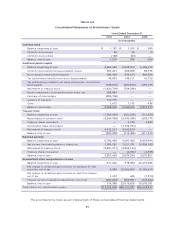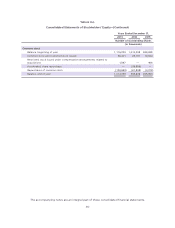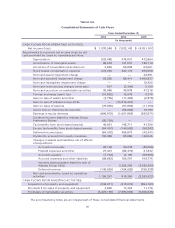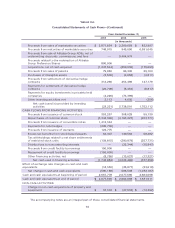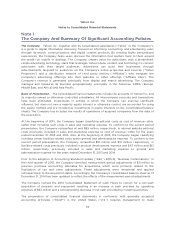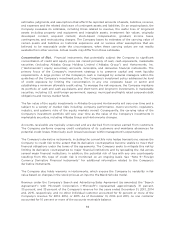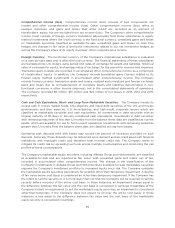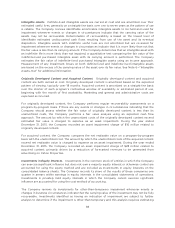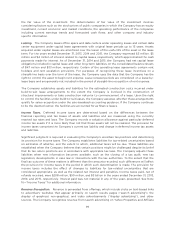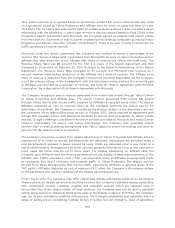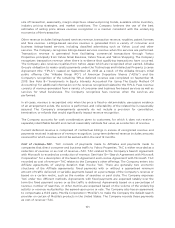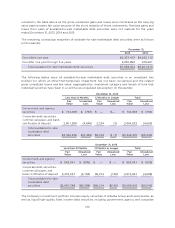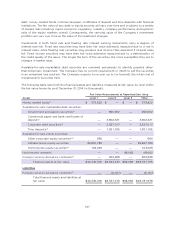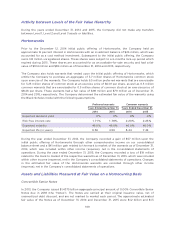Yahoo 2015 Annual Report Download - page 103
Download and view the complete annual report
Please find page 103 of the 2015 Yahoo annual report below. You can navigate through the pages in the report by either clicking on the pages listed below, or by using the keyword search tool below to find specific information within the annual report.the fair value of the investment. The determination of fair value of the investment involves
considering factors such as the stock prices of public companies in which the Company has an equity
investment, current economic and market conditions, the operating performance of the companies
including current earnings trends and forecasted cash flows, and other company and industry
specific information.
Leasing. The Company leases office space and data centers under operating leases and certain data
center equipment under capital lease agreements with original lease periods up to 15 years. Assets
acquired under capital leases are amortized over the lesser of the useful life of the asset or the lease
term. For the years ended December 31, 2013, 2014 and 2015, the Company expensed $5 million, $5
million and $4 million of interest related to capital leases, respectively, which approximated the cash
payments made for interest. As of December 31, 2014 and 2015, the Company had net capital lease
obligations included in capital lease and other long-term liabilities on the consolidated balance sheets
of $47 million and $33 million, respectively. Certain of the operating lease agreements contain rent
holidays and rent escalation provisions. For purposes of recognizing these lease incentives on a
straight-line basis over the term of the lease, the Company uses the date that the Company has the
right to control the asset to begin rent expense. Lease renewal periods are considered on a lease-by-
lease basis and are generally not included in the period of straight-line recognition of rent expense.
The Company establishes assets and liabilities for the estimated construction costs incurred under
build-to-suit lease arrangements to the extent the Company is involved in the construction of
structural improvements or take construction risk prior to commencement of a lease. Upon the right
to control the facilities under build-to-suit leases, the Company assesses whether these arrangements
qualify for sales recognition under the sale-leaseback accounting guidance. If the Company continues
to be the deemed owner, the facilities are accounted for as finance leases.
Income Taxes. Deferred income taxes are determined based on the differences between the
financial reporting and tax bases of assets and liabilities and are measured using the currently
enacted tax rates and laws. The Company records a valuation allowance against particular deferred
income tax assets if it is more likely than not that those assets will not be realized. The provision for
income taxes comprises the Company’s current tax liability and change in deferred income tax assets
and liabilities.
Significant judgment is required in evaluating the Company’s uncertain tax positions and determining
its provision for income taxes. The Company establishes liabilities for tax-related uncertainties based
on estimates of whether, and the extent to which, additional taxes will be due. These liabilities are
established when the Company believes that certain positions might be challenged despite its belief
that its tax return positions are in accordance with applicable tax laws. The Company adjusts these
liabilities when new information becomes available, such as the closing of a tax audit, new tax
legislation, developments in case law or interactions with the tax authorities. To the extent that the
final tax outcome of these matters is different than the amounts recorded, such differences will affect
the provision for income taxes in the period in which such determination is made. The provision for
income taxes includes the effect of changes to liabilities for tax-related uncertainties that are
considered appropriate, as well as the related net interest and penalties. Income taxes paid, net of
refunds received, were $208 million, $90 million, and $3 billion in the years ended December 31, 2013,
2014, and 2015, respectively. Interest paid was not material in any of the years presented. See Note
16—“Income Taxes” for additional information.
Revenue Recognition. Revenue is generated from offerings, which include clicks on text-based links
to advertisers’ websites that appear primarily on search results pages (“search advertising”), the
display of graphical, non-graphical, and video advertisements (“display advertising”), and other
sources. The Company recognizes revenue from search advertising on Yahoo Properties and Affiliate
99


